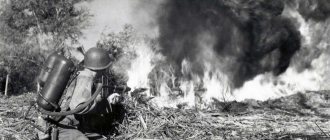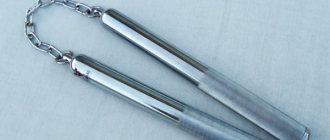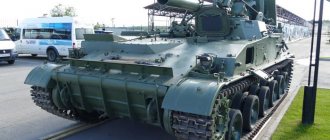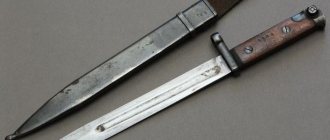“Made with us” and on Yandex.Zen
The simplicity of the design and use of the mortar, combined with good fighting qualities, quickly ensured that this type of weapon became widespread. More than a hundred years have passed since the advent of mortars. During this time, they maintained their popularity and continued to improve.
Now the development of new mortar systems continues in several countries, including Russia, where the Nizhny Novgorod Central Research Institute “Burevestnik” . Work to improve old mortars and create new ones concerns mainly two areas of the battalion level - weapons of 82 and 120 millimeters caliber.
First of all, it is worth noting the modernization of the 2S12 “Sani” complex with the index 2S12A. Adopted into service in 1981, the 2S12 system consists of a 2B11 mortar, a wheeled vehicle and a towing vehicle. The mortar itself has undergone major changes. The main element of modernization of the 2B11 mortar is a new base plate and the system for connecting it to the barrel. Previously, the barrel could only swing in one plane. Thanks to the use of a new base plate with a hinge, the updated mortar can also be aimed horizontally. This allows the fire to be transferred to another target without turning the heavy base plate. In addition, 2B11 received a number of new tools and capabilities.
The updated firing mechanism can be quickly and easily removed; disassembling the mortar is not required. On a special additional carriage stand there is a unit for attaching a sight, making it possible to aim the entire battery using only one sighting device. In addition, the updated “Sleigh” kit includes devices that allow you to quickly and easily align the sight, as well as fire at night.
120 mm mortar 2B11
Transport vehicle on Ural chassis 43206-0651
Wheel travel 2L81
In order to maintain maximum unification with the original 2S12 complex, the modernization did not affect the main part of its units. For this reason, the firing range and accuracy remained at the same level. As before, the Sleigh can fire conventional mines at a distance of up to 7,100 meters. When using guided KM-8 “Gran”, the range of hitting targets increases to nine kilometers. During the modernization, 2S12A received a new towing vehicle. Now this is a Ural-43206 truck or an MT-LB tractor. Transportation of a wheeled mortar can be carried out either by simple towing, or in the back of a truck or on the roof of a tracked vehicle. For loading, transport vehicles are equipped with a quick-release ramp of a tray design and a winch.
The updated composition of the complex’s equipment ensures a faster transfer of the complex from traveling to combat mode and vice versa, including by the forces of a reduced crew. Another project for modernizing an old mortar is called 2B24 and is a further development of the 2B14-1 “Tray” project. Due to its dimensions and weight, the 82-mm gun can be transported disassembled by a crew of four people.
The 2B24 design mainly differs from its predecessor in the length of the barrel. This innovation made it possible to significantly increase the maximum firing range; it is now equal to six kilometers. The 2B24 mortar can fire all available 82mm mines. In addition, during its development, a high-explosive fragmentation mine of increased power 3-O-26 was created.
Like the mortar of the 2S12A complex, the 2B24 has a new joint between the barrel and the base plate, which allows firing at targets in any direction, just by turning the barrel and rearranging the carriage supports. The permissible rate of fire of the gun increased to more than twenty rounds per minute. To ensure an acceptable temperature regime of the barrel and to avoid its deformation, there is a radiator fin on the breech.
Mortar 2B14 “Tray”
Being portable, the 2B24 mortar can be disassembled into three main units, which are packed into packs. One fighter carries the barrel, the second carries the base plate, and the third carries the two-legged carriage and sight. The fourth crew number carries a special backpack-pack for ammunition. Without any changes in design, the 2B24 mortar can be converted from portable to self-propelled. To do this, using a special mounting kit, the mortar is installed in the troop compartment of an MT-LB armored tractor. This complex was called 2K32 “Virgin”.
It is noteworthy that the 2F510-2 mounting kit allows you to quickly remove the mortar from it and use it in a portable version. The ammunition load of the 2K32 combat vehicle is 84 mines. Of particular interest is the 82mm 2B25 Gall mortar. First of all, attention is attracted by the dimensions of this weapon. With a significant caliber, when disassembled it fits into just one container. The Gall crew consists of two people, one of whom carries the mortar itself, and the second carries the ammunition for it. Despite its small size, the 2B25 can fire at targets at ranges from 100 to 1200 meters.
However, the most interesting element of the complex is the new 3BO35 fragmentation mine. The main innovation in its design is the original shank with a propellant charge. Inside the shank there is not only a charge, but also a cylindrical piston. Before firing, the mine is placed in the mortar barrel, after which the firing mechanism ignites the propellant charge. The powder gases, expanding, push the piston out of the shank, which, in turn, rests on the tile of the firing mechanism and throws the mine out of the barrel. Having reached the extreme position, the piston gets stuck inside the shank and does not allow the powder gases to escape, due to which the sound of a 2B25 shot is only a few quiet pops and clicks.
Mortar 2B25 "Gall"
The 2B25 Gall silent mortar was first presented last year at the MILEX-2011 exhibition in Minsk. At the same time it became known that serial production of the mortar had already begun. There is information about the continuation of work to improve the Galla in order to increase the firing range. However, even without any changes, the 2B25 mortar is the world's first serial silent mortar with a powder charge for throwing ammunition. Despite the fact that all the main nuances of the mortar design have long been invented and “polished”, the development of such systems still continues. The development of this area primarily concerns measures to improve the range and accuracy of fire, as well as lightening the design. The creation and use of adjustable ammunition is also considered a promising way to improve mortar systems.
As for special designs like the silent 2B25, this is rather a special tool for special units, but not a weapon for a mass army. At the same time, not enough time has passed since the beginning of the use of “Galla” (if any) and it is not yet possible to draw conclusions about the prospects of the entire direction.
Perhaps in the future mortars will be created that combine the combat qualities of the updated 2B11 and the silent 2B25, and these weapons will begin to be supplied to the troops in large quantities. These are just guesses for now, but what the mortar of the future will look like can only be said in a few years, when specialists from the Burevestnik Central Research Institute show their new developments.
Battalion 82mm mortar
In 1936, a mortar launcher developed at the Leningrad SKB-4 under the leadership of D.I. Shavyrin was adopted by the Red Army. The 82-mm mortar had its baptism of fire in the battles at Khalkhin Gol, establishing itself as a reliable military weapon capable of hitting enemy targets at long distances. Subsequently, these artillery pieces were modernized.
Thus, new modifications of the 82-mm mortar appeared annually throughout all hostilities. These World War II mortars served faithfully for many years to come. Not a single military operation of the Soviet troops was complete without these weapons.
The successful use of mortars in World War II of this caliber led to their becoming the prototype for a lightweight version of the 1981 Model Tray mortar.
Urban warfare
For example, during the Vistula-Oder offensive operation, in order to break through the 8-meter walls of the Poznan citadel, charged high-power projectiles were rolled into launchers for direct fire. The Katyusha's firing range was four and a half kilometers, but at direct fire it was only one. Shooting at a shorter distance was simply impossible.
Nevertheless, the mortar guards managed to adapt their formidable weapons for street fighting. From Moscow to Berlin, the Guards "Katyusha" - a mortar of the Second World War - took an active part in all combat operations.
By the end of the war, the BM-13 became a weapon of mass destruction. The first official fireworks display in the Great Patriotic War took place in August 1943, in honor of the liberation of Orel and Belgorod. It became an echo of the first volleys of Katyusha rockets in July 1941.
War statistics
It is interesting to compare how, in quantitative terms, the USSR mortars of World War II were produced in comparison with other countries. So, the numbers:
- The United States of America produced about 111 thousand units of military equipment between July 1940 and July 1945.
- Over the entire period, which is 1939-1944, the British military industry produced 97 thousand artillery weapons of this class.
- From the beginning of 1941 to the middle of 1944, Germany managed to equip its army with almost 70 thousand mortar launchers.
- From July 1, 1941 to June 30, 1945, the Soviet Union produced 348 thousand mortar artillery mounts of various calibers.
These figures indicate that the USSR mortars of World War II were very popular and made an invaluable contribution to the victory over Nazi Germany.
Characteristics of the 50-mm company mortar mod. 1940
A country:USSRType:Company mortarDate of issue:1940Calculation:2 peopleCaliber:50 mmLength:780 mm (barrel length 553 mm)Width:No informationWeight:9 kgRate of fire:30 shots/min.Firing distance:up to 800 mInitial projectile speed:97 m/sAmmunition:Transportable. 50 mm feathered mine weighing 0.85 kg
The characteristics are given for a 50-mm mortar of the 1940 model.
Improved fuze
Perhaps the most important thing about the M224 mortar is its ammunition, especially its multi-purpose fuze. The mortar can be fired with high-explosive fragmentation, illumination, smoke and practical mines. The multi-purpose fuze is designated M73 and is one of the world's first electronic fuzes adopted for service. It can be set to trigger at high altitude, low altitude, impact and delay.
The fuze has a built-in switch that automatically switches to the next trigger type if the selected trigger type fails. For example, if the fuse did not go off when set to operate at low altitude, it will go off on impact, that is, when the mine falls to the ground. If this does not happen, the fuse will switch to delayed operation. The energy to power the microcircuit is generated inside the fuse during the mine's flight by a miniature impeller turbine located in the nose.
The ability to select the trigger height with a high degree of confidence that the fuse will not fail increases the destructive effect of the mine. Moreover, the area of fragmentation damage is comparable to the effect of an 81 mm mortar mine. However, the electronic fuze is expensive to produce, so it must be produced and sold in large quantities to bring the price down to an acceptable level.
Interesting Facts
It is known that mortars from the Second World War destroyed not only ground targets.
In 1942, during the defense of Sevastopol, junior lieutenant Vladimir Simonok shot down a German Junkers flying low over the positions of Soviet troops with a direct hit from an 82-mm mortar. This was the only time during the entire Great Patriotic War when a mortar crew hit an enemy air vehicle. For this fantastic shot, junior lieutenant Vladimir Polikarpovich Simonk was awarded the title of Hero of the Soviet Union. Unfortunately, the lieutenant died in the same year, 1942, defending Sevastopol.
Three modifications
The M6 60 mm mortar is available in three modifications: M6/214 “Standard”, M6/314 “Long Range” and M6/530 “Light”. The most widely used model is MB/214. The difference between the M6/314 is the elongated barrel. The M6/530 "Lait" mortar, also known as the M6/350 "Commando", has a lightweight barrel without a biped and a small base plate, as it is designed for one-person operation and can be equipped with a firing mechanism with a trigger. All of the listed mortars can fire almost any 60-mm mines, but the ZMI company has launched the production of its own HE 80 high-explosive fragmentation mine weighing 1.6 kg. When used from the M6/314 mortar, its firing range is 4200 m.











